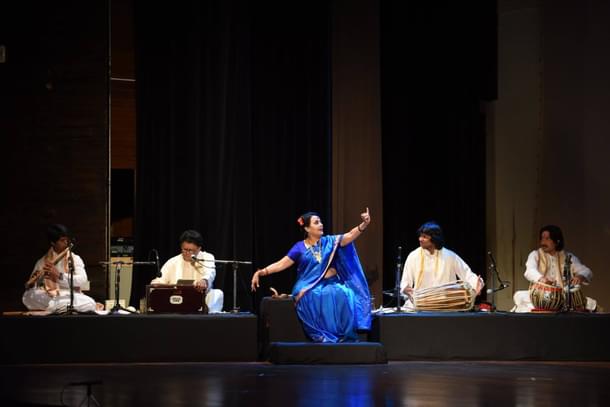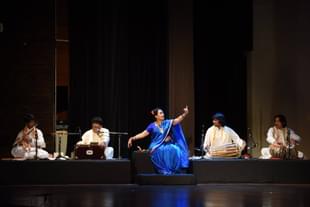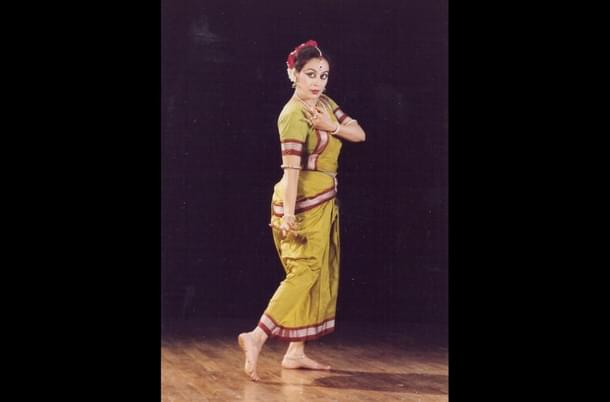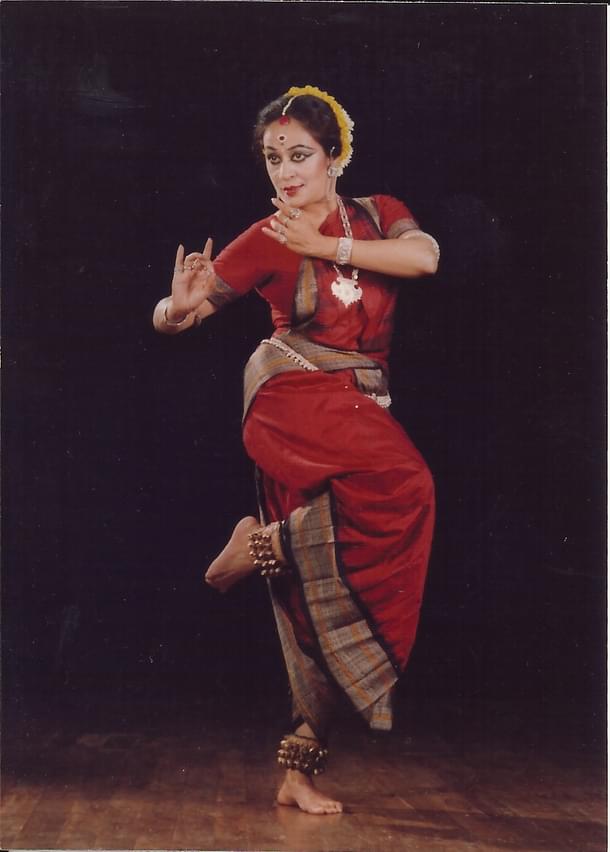Culture
The Devi Of Navarasas: How Guru Sonal Mansingh Continues To Explore The Arts And Indic Traditions At 75
Sumati Mehrishi
May 11, 2018, 05:41 PM | Updated 05:41 PM IST
Save & read from anywhere!
Bookmark stories for easy access on any device or the Swarajya app.


World renowned Odissi and Bharatanatyam guru Sonal Mansingh turned 75 recently. Sonal Mansingh's life marked by many personal milestones, clearly, is about her “tapasya” in the arts. It is a life shaped by experience, a flaming passion for life, spirituality and a razor sharp focus of mind dedicated to the exploring of classical Indian dance and music. Sharing her art, views and wisdom, she is radiant at all times, sometimes pensive, smiling, sometimes thrilled, singing, chuckling, generous, sometimes curious and sometimes angry. At 75, she is turning into a reflection of a devi - living under the brilliance of the navarasas. The navarasas, over decades of practice, thought, teaching and performing, have immersed her in the continuing study of the arts, Indic philosophy and texts.
Swarajya met the guru at the Center for Indian Classical Dance, called Shri Kamakhya Kalapeeth, in New Delhi. She discussed aspects on music, dance, themes and performance, sparing some precious time before and from a rehearsal at this year's edition of KalaYatra. A journey of the arts and performance celebrating many personal milestones woven together, Kala Yatra becomes a beautiful celebration of her dance foundation, life and work. The theme of this year's Kala Yatra was Devi. The chief guest at Kala Yatra is Goddess Kamakhya Devi.
Sonal Mansingh's students presented their rendition to the Devi, in Kala Yatra, continuing the flow of sadhana and parampara under their guru. Edited excerpts of her conversation with Sumati Mehrishi.
The preparation for your arangetram was a journey in itself. During the practice sessions, there was a moment when your guru asked you to observe a monkey because you could not get the right expression. How do you look back at your arangetram today?
As you said, that one sentence has remained with me all my life. And it will remain, because I am still trying to find the difference. There are monkeys which are very trained and very refined. Somebody sent me a video on WhatsApp, where a monkey comes to a katha, ashirvad de raha hai ... aaraam se prasad kha ke chala jata hai (he is blessing people, he has the prasad and leaves). Such monkeys are there, too. So, what's the difference between the monkey and me? I don't want to be this kind of the monkey who is scratching, looking here and there. It is very difficult, because the mind is monkey. It jumps. Somehow, I trained my mind in a day. I can sustain a thought process, because that kind of focus is very dear to me. Kind of laser... and unless we develop that, things don't happen. My arangetram was wonderful and Devika Rani had said that you are a born dancer, make this your tapasya. Which I did. My grandfather later said that don't make it your ‘dandha’. ‘Dukaan daari nahin karna’ (don't turn dance into business). That has remained with me. Therefore, I could not even buy my own flat or house. Then, he said that in history there has been stigma. You have to prove...
Where do auchitya and maryada figure in an artiste's life?
Auchitya and maryada are beautiful words. If you don't realise what position you have to take between what is appropriate and what is not... (Realising that) is what I call the 'balance'. More and more, these days, one finds a lack of it, because there is no thinking through and there is the 'quick return' mentality. You should know what you can do well and what you cannot do well.
How would you explain nritya, nritta and natya?
Nritya is very simple. Where the body is engaged with, primarily, rhythm. Yato hasta tato drishti -- yes. Yato drishti tato mana – yes. Yato mana tato bhava comes later. That comes in nritya, where rhythm and melody and text join, where you start using the hasta mudras, the mukhaja, facial expressions, and combine it with your own interpretation. Natya, again, is going farther. That's what you call 'theatre'. What is theatre? What is the difference? That's a very pechida question. Like my Draupadi was natya. Ashtapadi is not natya. It is nritya. The situations are elongated and magnified in natya, I think. And natya can use much more – property, dramatic lighting, because in solo dances, property to hota nahin. It is just yourself, with your costume, and you create. I think natya is also very challenging because the whole point in my mind is to maintain balance. You don't go overboard in nritya. In nritya, nritta, nritya and natya, all three are required. A lot of balance - of thinking. Of movements. Of control. Even if it is natya, it doesn't mean you start making faces. As a solo natya prastuti, natya as dance drama is different.

Music has been a very important part of your journey in dance. What led to the wide explorations in music and ragas with Guru Jivan Pani and Bankim Sethi?
I had learnt music form my childhood. Gujarati folk music at school, also classical music at school and having had met the great masters of the time in my Dada ji's (grandfather Shri Mangal Das Pakvasa) Raj Bhawan, where they were regular guests. Mehfils and baithaks were there - the whole sanskar of music at home. We were learning from professor K G Ginde, who was with Professor Shri S N Ratanjankar, (Bhatkhande school of music) and he was contemporary of renowned vocalist and musicologist Sumati Mutatkar. Big names. I also learnt sitar for three years, also, mridangam and pakhawaj, to know the strokes, because, the mnemonics, the sholukattus and the ukkuttas. How they correspond to the played percussion. Music is incomplete without swara and laya. So, nobody can fool me. That's also another thing that I have realised over the years. That is how good it has been to go through this entire gamut.
You focused on ragas for text and compositions in dance. What led to that?
Bankim was singing for Odissi before Jiwan Da (Guru Jiwan Pani) entered my life (that was Bharatnatyam I was always dancing). Carnatic music was with me all the time. Carnatic musicians and bharatanatyam musicians were very strong. And my bharatanatyam was famous. I started Odissi in 1965 for a while and then I went to get married. I came back to continue for a while under Guru Kelucharan Mohapatra ji, my guru ji. In May 1972, even that was over. I continued Odissi with my gurubhai Shri Hare Krishna Behera (well-known exponent of Odissi and guru), who played the pakhawaj. Bankim came to Delhi in the early 1970s and was brought to me. We trained him to sing. All the Odissi music at that time was Kelu babu's music composed by Pandit Bhuvaneshwar Mishra, the violinist who had learnt from his guru Dwaram Venkata Swamy Naidu, in the carnatic style. The singing was partly Hindustani, partly Carnatic. And all the ragas that we used were pallavis and ashtapadis. They were man gadhant (loosely imagined). I will give you a solid example.
Pashyati dishi dishi rahasi bhavantam – the lovely ashtapadi. The sakhi is the go between Radha and Krishna. She is reporting to Krishna how desolate Radha is, therefore, you (Krishna) should go to her quickly otherwise she will give up her life. Very poignant. Jaidev's text is superb. It was being sung in Raag Desh, which is basically a happy, utthta hua raag (a pleasant and soaring raga). It is sringarik.
Lalita lavanga lata, the ashtapadi by Jaidev, which is about the spring Vasantha – that was sung in the Adi Vasantha of Carnatic music. Adi Vasantha is very pensive. A very heavy raag. Here, the vasantha ritu – what all happens (in the season). So, for a few years at the beginning, very often I felt, because my sensitivity was sharpened much more than the usual because of reading, my background, the thirst to know, 'yeh baith ta nahin mere saath'. It is not fitting in with me. It is somehow not bringing out the mood and the flavour of the text.
I am specially speaking of the Geet Govind here, because Geet Govind is the prime text for me and for Odissi. The other texts were already composed and done with whatever which and which.
I got to know Jivan Da, when he came to Delhi. I was introduced to him in Puri. My father-in-law had taken me to Konark and Puri and he introduced me to him. He said that Sonal, whatever questions you have about Odissi and the aesthetics, you can discuss with Jivan da. That's how we met. Jivan Da came to Delhi (I think) in 1970 at the invitation of Dr Kamaladevi Chattopadhyay and he joined Sangeet Natak Akademi where she was the chairman. I was in its general assembly. We (Guru Jivan Pani and I) reconnected. I started telling him that I am not content with this. Why don't we go into this? I said that whenever I have seen the Geet Govind, the ragas are given. Why this discrepancy, and in a way, injustice to poor Jaidev? I had danced to Tagore on his centenary and noted singer Pankaj Mullick had come from Calcutta.
For Thyagaraja, Shama Shastri and Muthuswami Dikshitar, you cannot, not even an iota, go away from the set music. Why the poor Jaidev has been given this treatment? Where are these ragas? Jivan Pani ji said that he loved challenges. He told me 'I have not found anyone like you'. He was a scholar poet. What a man!

How did you all arrive at the depth in the ragas and ragas that fit the context and depictions?
Jaidev's almost contemporary was (Sarandev's) Sangeet Ratnakar and there we found all the ragas. We found all the dhyaan shlokas. We found the vaadi samvadi. We found the jeevaswara. We found the arohana and avrohana. What more do you want? So, when we found the Vasantha, for Ialita lavanga lata, Bankim was part of this whole process. Later, we called him and in my old house, in the garage, which was my work place – what things came out of it. The place simply seemed to expand. And all this was given to Bankim. I said let's see what you can do with it tomorrow. He just worked a little bit and when he sang a little bit, I said "ho gaya" (it's done). It was totally different from Hindustani Basant and Carnatic Vasanth. You feel the spring in air. You can feel the blossoms. You can feel the soft air. You can see the lotus bloom.
Pashyati dishi dishi - it is to be sung in (Raag) Gunakri. Pandit Ravi Shankar ji came to dinner and I called Bankim ji and Jivan Da, my mother was also there. And Ravi shankar ji said, "Arre, yeh to Dhani jaisa hai (this is like Dhani)." I said Dhani iske jaisa hai (Dhani is like it). If you say that my grandfather looks like me (it's funny), I look like my grandfather. (laughs)
Gunakri is inherent in Assamese music. So much of their borgeets they are in Gunakri. They are not called Gunakri because they don't know it.
It is not sad. But there is a kind of pleading yearning in it. (Sings) "Naath hare...". And In Raag Desh, you know, it is not there. Bharatanaytam has its own music.
Now, coming to Caryagiti. A very simple-looking lady in Trichur in Kerala posed a question to me. 'Madam, can you please quote me one varna, one padam, one keertanam, where the poet, usually they are all male, addresses our goddesses as beloved. 'No'. I said, 'I will find out and come back to you. Thank you.'
I told Jivan Da. Lakshmi or Parvati or Radha or Saraswati, they either stand alone or as wife or consort of someone, beloved of someone, mother of Ganesh... It is never the poet saying 'Oh my beloved Radha, oh my beloved Parvati', oh god, they'd rather die. So, why this? After a week he came rushing to my house. And he said that the answer is in the Caryagitis. The sadhaka is always a male. High caste male. The sadhya (goal, for which he is doing the tapasya) is depicted as a low caste woman (today, in these times, I have to find ways and means to express how to ...) I was like, oh my god. The siddhas who wrote these always addressed directly. "My beloved." These Caryagitis also have similar ragas given. So, the impact is doubled. Concept and text trebled. I am not saying how we dance it.
In 1960s, even before I was married, I was already a star in Bharatayam. So, I brought Tulsi, Meera, Surdas and people were quite happy to hear something. But here in Odissi, it was a great challenge, the gurus and musicians were not able to digest this. Because they had already formed a self-created opinion. So, we orgainsed a seminar. In 1983, at the Russian Cultural Centre, we brought Pandit Kashninath Pujapanda and other singers and scholars of Orissa. Dr Sumati Mutatkar was there, Bankim was there, Bharatanatyam and Carnatic musicians were there. I did a unique thing which others have not been able to repeat and I think it is time I did it again. We took Vasanth, for example. We saw Sumati ben singing Basant (hindusthani), Radha Krishna singing Adi Vasantha (carnatic), Bankim singing Sangeet Ratnakar's Vasanth. What's this!
Then, Raag Shri – the Hindustani (tradition) Shri is again very pensive.
Raag Shri tucks into you near the belly... Tell us more.
The Hindustani Shri clutches you at the guts. South Indian Shri is like raag Brindavani Sarang (demonstrates through singing). Is it Shri? Very different. They said it is something like Bageshri. 'Something like', but not Bageshri. It is not Bageshri. Like that, we demonstrated four to five raags. Everyone went absolutely gaga.
The problem with me, Sumati, is that I don't know marketing, branding, claiming, disclaiming. I just share. Mujhe anand uska hai (sharing provides me anand). Someone was telling me that the love and affection you get even from common people, it is amazing even today.
Sutapa (well known Odissi exponent Sutapa Talukdar, disciple of Guru Kelucharan Mohapatra), a very senior artiste from Kolkata, came the other day. She said, Sonal ji, I want to learn this and that from you. Yours is very different. It gets you.
What gets you is the original. It's not Sonal. It is that which Jaidev envisaged.
You have been vocal about the delaying of honours to Kamaladevi Chattopadhyay and Indrani Rahman. How do you look back at those years and the two great women?
Indrani was not honoured with even a Sangeet Natak Akademi award (back then). In Kamala Devi's chairmanship, I put it on record in many interviews. Dr Kapila Vatsyayan was adamant on giving the award to Kalanidhi Narayan (well known dancer and guru of Bharatanatyam) who had after thirty years come back on the scene. My argument was that Indrani Rahman should be given her due for bringing Bharatanatyam to North India, and Kuchipudi out. And her contribution has not been rewarded. So, Kamaladevi ji tilted towards me, much to Kapila ji's chagrin. Indrani got a belated award. Indrani had also learnt from my guru Shri U S Krishna Rao sir and Chandrabhaga Devi. She was doing a lot of programmes abroad. Indrani was the ruling queen of Bharatantyam. She used to often come to Bangalore for programmes and used to visit my guru. Lot of laughter. She saw my practice session. She also came to Sapru House. It was a big mecca of arts then. They were going to have their first festival, to invite me. I was given a grand sum of Rs 490 to Rs 500. It was Indrani who introduced me to Delhi. And I was the first (to perform) on the opening day. After Damayanti Joshi (renowned exponent of Kathak). (There were) Roshan Kumari (renowned dancer, actor and choreographer), Indrani Rahman and Ustad Vilayat Khan. And that gave me the opening like nothing else. Indrani had the knack of picking up, I believe, Guru Radha Raja Reddy. Indrani had that generosity of spirit which is not usually found in dancers.
Kamala Devi Chattopadhyay should have been given the Bharat Ratna. It is so male oriented (except Lata Mangeshkar, M.S Subbulakshmi, Mother Teresa and Indira Gandhi). May be I am missing a name. Balasaraswati hasn't got it. Rukmini Devi Arundale didn't get it. Kamaladevi ji should have got it long ago.
India is very male oriented. The polity is very male oriented. The thinking is very male oriented, more and more now. I am sorry that in Atal ji's (former prime minister Atal Bihar Vajpayee) time, no body thought of it. I put the blame on myself.
Kamala Devi ji created a whole generation of workers and scholars. The punarutthan, the regeneration, the renaissance of not only the Indian textiles and handicrafts but through that the whole thought woven into it. Kamala Devi ji was an institution, a guru.
Few years ago, you had gone to Varanasi for a special performance dedicated to Ganga. Saptanadi has been an important work in your repertoire. Tell us about your love for Indian rivers.
I am a very good swimmer. And I have swum in almost two dozen rivers of India, including Krishna, Godavari, Kaveri, Narmada, Tapti, Ganga, Yamuna, Son. Except Brahmaputra. I love water. I love rivers. Rivers always remind you of life. The flow. How a river flows, circumvents, makes her way through rough difficulties. Then, the saptanadi are also part of all the kriya karma. Whether sad or happy. So, why these seven rivers? What's the mystery? Asmita, my choreography in 2001- 2002, has a section of all the seven rivers and dances. Like on the banks of Saraswati, a Yagya has been performed. Saraswati is the only river mentioned in the Rig Veda. Ganga and Yamuna have their own history. Narmada is the oldest river after Saraswati. Narmada is such an important river that even Ganga is supposed to go and bathe in Narmada, because millions wash their sins in the Ganga. What kind of connection are these that we miss out? What is Brahmaputra's history? Now and then, I keep adding to this.
In Japan, the early 2000s, you performed Odissi with a Noh master. What aspects of dance did this performance reveal?
Noh and Butoh. I have seen a lot of Noh. You need a lot of patience and concentration. It is so delicate, I get goosebumps even thinking about it. And I got an opportunity to do a lecture demonstration with a Noh master. They are so controlled. Our control is a dynamic control. The difference... they say Noh Kathakali jaisa hai. Jaisa nahin hai. (they say that Noh is like Kathakali. It is not like Kathakali). The lecture demonstration was an eye opener for many. I was alone. The Noh master had his flautist and his drummer. I showed him how we can also go ati vilambhit, especially in the abhinaya.
Spicmacay had celebrated Noh and Koodiyattam in special performances during the early 2000s. Is it possible to see Noh celebrated with Odissi, too?
Spicmacay has dropped me like a hot potato. For some years now. I was one of the pillars of Spicmacay. It's ok.
On exploring the concept of kanya in her work Panch Kanya, a series on women of contemporary relevance:
I am not going into the meaning now. Each word in Sanskrit has its own meaning and context. And I think, today, we have lost the education and the desire even to understand. Kanya is not Kumari. Kumari is the unwed woman. There are five names of kanya in the ancient tradition. Why the kanya? What does the kanya mean? Ramayana and Mahabharata. Mahabharata is itihas. Epics mean itihaas. Iliad and Odyssey – itihas of Greeks. That whole area of meanings. I am not going into what people say. Ramayana Mahabharata are epics. They are itihaas. They are mahakavyas. So, two from Ramayana, three from Mahabharata. The concept of kanya then joins with characters from itihaas.
Krishna is itihaas, Radha is concept. Radha is not real. We make her real by our own imagination, our own imagery, our own bhava. Utakat bhava. Radha is concept. Krishna is itihas. How do they mix? You cannot take his name without Radha Krishna - Radha Vallabh - Radha Govind. How? There is a unique talent of Indic traditions, Indian mind. How you mix and match, create a totality and yet make you aware. That, what you call maya, is there. Reality is there. It is up to you how you look at it. The field is open.
(Pictures: Guru Sonal Mansingh)
Sumati Mehrishi is Senior Editor, Swarajya. She tweets at @sumati_mehrishi





